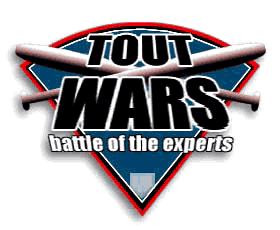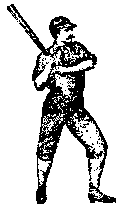 I was writing this story today, No. 9 of the Most Misunderstood Concepts, when I got a call to be on Jeff Erickson and Chris Liss’s SiriusXM radio show to talk about this very topic. Do they have ties to the NSA? Nah, it’s just hot stove time and we’re all thinking about how to find edges come draft time. We’re just two months away.
I was writing this story today, No. 9 of the Most Misunderstood Concepts, when I got a call to be on Jeff Erickson and Chris Liss’s SiriusXM radio show to talk about this very topic. Do they have ties to the NSA? Nah, it’s just hot stove time and we’re all thinking about how to find edges come draft time. We’re just two months away.
That radio appearance led to a long conversation on Twitter about why pitchers sell for a discount and hitters a premium at auction time. I’m going to lay out my case here in a little more depth than I intended to because of some of the issues that have come up in that conversation. There’s so much related information that I broke it up into two parts, that I hope you’ll find chock full of helpful ideas.
Everybody knows that when a Rotisserie Auction is over about two thirds of the money spent has gone to hitters and one third has gone to pitchers. Well, that’s the way it used to be. Now it’s more like 69 percent to hitters, 31 percent to pitchers. Different, but pretty much the same idea.
Now, this was true in the first auctions back in the game’s earliest Rotisserie days, and has (with some drifting as noted, because of the shift from 4×4 to 5×5 and rules changes and perhaps also the way the real game’s rosters have changed) stayed constant in all the years the game has been played.
This is true as well regardless of what individual owners in the league do. An owner or two spends $125 on pitching, the split will still be about 68/32. An owner or two spends $30 on pitching, the split will still be about 68/32. Or very close. The split clearly represents the market for pitchers in fantasy baseball. It isn’t a whim or evidence of mass psychosis. It is the market.
What is problematic about this is the absolute fact that half the value in a fantasy league playing 5×5 or 4×4 comes from pitchers and half comes from hitters. All surface logic should argue that our budgets for the two parts should be equal, but they are certainly not. The operative questions are why does it work like this and what does that mean for our strategies?
One possible reason for the split, long ago considered and pretty much rejected, is that the split reflects the composition of a Roto roster: 14 hitters and 9 pitchers (a 60/40 split as it were). First off, 60/40 is different than 65/35. Secondly, over the years we’ve moved from 65/35 to 61/39 while the roster composition has remained constant. So while there is superficial congruence here, I don’t see any reason the number of roster slots outweighs the logical certainty that hitters as a group earn the exact same amount as pitchers as a group.
(For the sake of completion, one reason to credit the roster slot theory and the change in the split over the years is because since the dawn of the fantasy era, major league teams have changed the way they make up their rosters. There are far fewer hitters in the majors today, and many more pitchers. The reason why I don’t think this supports the roster composition theory is because the same exact dynamic pertains in the other theories as well.)
Another suggested reason for the split is because of the imbalance in Qualitative Categories (BA for hitters, ERA and WHIP for pitchers). That’s a 33/67 split, which is definitely in the ballpark. And there is logical power here, too. The major league averages in the Qualitatives is generally right around the bottom of the fantasy league standings in those cats (if you average a lot of teams together).
So, inevitably, hitters on fantasy rosters can generate substantial negative value in batting average, while pitchers can generate substantially more negative value in ERA and WHIP. Does this downward price pressure explain the split?
Partially, I think. Here’s why:
I compared the Draft Day prices paid in three startup so-called expert auctions (CBSsports, LABR, Tout Wars) with properly populated end-of-year prices for the Top 108 pitchers and Top 168 hitters in each league. When you sort by the Draft Day prices you learn that:
The expert leagues spent, on average $4355 for 336 hitters (in AL and NL leagues combined).
If you then tally up the end of year profile of that group of players you learn that they earned a total of $3811, a loss of 12 percent. You also can see that 262 of the draft day players (78 percent) earned a positive value. The 22 percent group of losers lost a total of $323.
Compare that with pitchers: On draft day the experts spent $1855 for 216 pitchers (in AL and NL combined).
When you tally up the end of year profile of that group of pitchers you learn that they earned $591, a loss of a whopping 68 percent. 122 of the drafted pitchers (56 percent) earned a positive value. The 44 percent group of losers lost a massive $936!
So, the hitting losers lost $323 of $4355 (or 7 percent), while the pitchers lost $936 of $1855 (or 50 percent). That’s a massive difference, and the reason for most of the difference is because in the Quantitative categories you can’t really lose money (actually you can lose the value up to the output of the so-called Replacement Player, but practically this is a small amount and a player’s contributions in the cats he does contribute completely overrides the hit in value he takes if, for instance, he hits zero homers), while a player can lose tons in the Qualitatives if he plays enough.
And, not only do pitchers have two Qualitative categories, but they are for the most part duplicative. If you’re going bad in WHIP you’re generally going bad in ERA too, so it’s a double whammo, compounded because pitchers who put up a fair number of innings pitching below league average are generally not earning any value in the Saves category and probably aren’t winning as many games as better performing pitchers either. May I introduce Lucas Harrell?
So, does the Qualitatives distribution explain the Split? Partly. Part of the reason for the split is that so many pitchers selected on draft day fail, which is a good reason to discount them. But that doesn’t explain another fact: The $20+ pitchers on draft day last year cost $468 and earned $417, a return of 89 percent. This compares favorably with the rate of return for hitters who cost $20 or more, which was 83 percent.
If the most trusted pitchers are just as reliable as the most trusted hitters, why wouldn’t we pump more money into that group?
It feels like past time to take a break, but let’s tackle that problem next.



Pingback: What Is The Ideal Spending Allocation Between Pitchers and Hitters? | Smart Fantasy Baseball